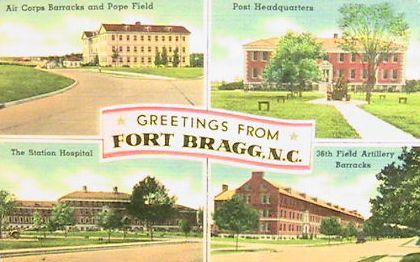Boom Town: Fort Bragg During WWII
Germany’s invasion of Western Europe on May 10, 1940 led directly to a massive buildup of training bases across America, including Fort Bragg. The Nazi Blitzkrieg was a clear warning that America had to be prepared to defend itself against aggression.

With a massive infusion of construction money, Fort Bragg and nearby Fayetteville became “boom towns”, as workers poured into the region from all over North Carolina to begin constructing mobilization buildings to house thousands of new Soldiers, both volunteers and draftees. Initial construction plans called for enough housing to boost Fort Bragg’s population from 5,000 to 66,000 troops. The project was colossal, with over 31,000 men working seven days a week, twenty-four hours a day. Roads were built through pine forests and, at one point in the construction, new buildings were erected at a rate of one every 32 minutes. It was during this time that modern day Fort Braggbegan to take shape.
Millions of board feet of lumber were supplied by seven hundred lumber mills throughout North and South Carolina. Building suppliers in Fayetteville became major companies as a result of the expansion. In 1939, Fort Bragg had just over 250 permanent buildings on post. By August 1941, the installation counted more than 3,000 permanent buildings, including barracks, office space, hospitals, chapels, libraries, exchanges and service clubs. The daily payroll averaged $100,000. Army finance figured that $140 was spent every minute. When completed in August 1941, the cost of the project had reached $44,681,000.
President Roosevelt paid a special visit to Fayetteville and Fort Bragg at the end of March 1941 to get a first-hand report about the expansion effort. The scale of the project impressed Mrs. Roosevelt, but she worried about the impact that an enlarged Fort Bragg would have on nearby Fayetteville. When World War II erupted in Europe in 1939, Fort Bragg had fewer than 3,500 troops. It was a small artillery training post, with the sleepy southern town of Fayetteville to its south. At the height of the war, Fort Bragg’s population peaked at 159,000 troops. By war’s end, Fort Bragg would become the Army’s most popular post, making it one of the nation’s most important military installations.


Did you enjoy this content? Please consider giving a gift to the ASOM so we can continue our mission of educating the public on the histories of Airborne and Special Operations Soldiers.




